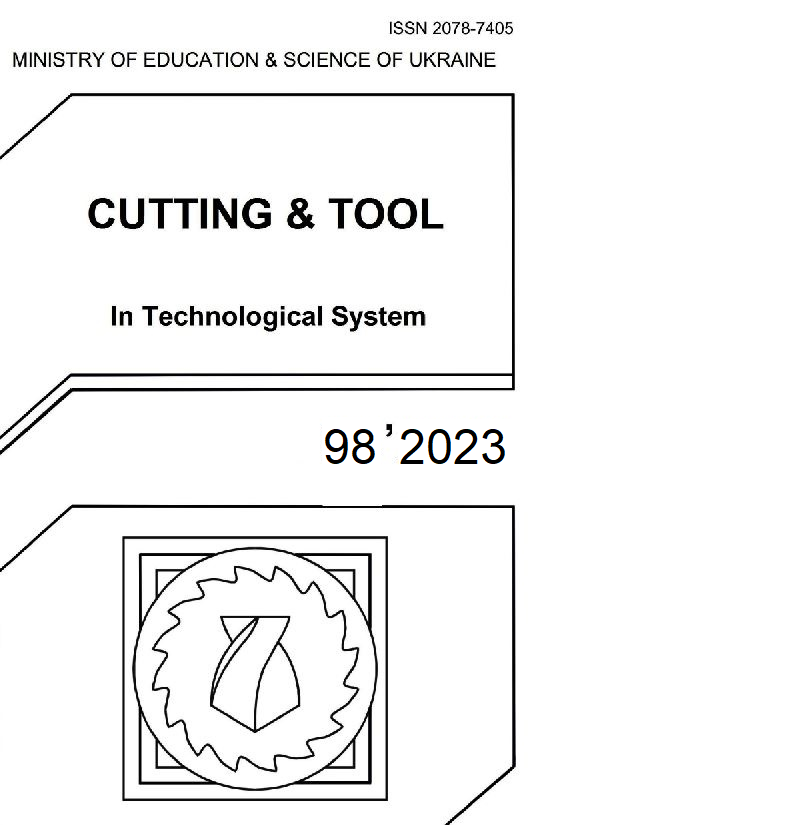REGULARITIES OF VIBRATION FINISHING AND GRINDING PROCESSING AND DIRECTIONS OF IMPROVEMENT OF ITS INTENSITY AND QUALITY
DOI:
https://doi.org/10.20998/2078-7405.2023.98.04Keywords:
vibration treatment, technological capabilities, intensity and quality, amplitude and frequency of oscillations, trajectory of the reservoir, metal removal, ellipse coefficient, granularity of the medium materialAbstract
The data on the labor intensity of manufacturing engineering products and the share of finishing and grinding operations in the total labor costs of their manufacture are presented. The list and the degree of mastering the technological operations of finishing and grinding processing, performed in the conditions of machine-building industries during the last years are given. The grounds are given for highlighting the method of vibration processing as the most promising for ensuring complete mechanization of the process of finishing and cleaning, as well as achieving high technological characteristics of the surface roughness of parts. An assessment was made of the influence of modes, the trajectory of the movement of the reservoir and the grain size of the granules of the abrasive medium on metal removal. It is indicated that the intensity and quality of vibration treatment is estimated quantitatively by the weight removal of metal and qualitatively by the roughness of the processed surface. It is indicated that the determining factor in this case is the speed of the oscillating movement of granules and parts, the difference of which represents the speed of vibration processing, depending on the speed of the oscillating movement of the medium. It is noted that in order to increase the productivity of the process, it is necessary to increase the speed of the medium by increasing the frequency and amplitude of the reservoir oscillations. The layer-by-layer transmission of a force impulse from the bottom of the reservoir to the bulk medium is considered. The physical meaning of increasing productivity by increasing the amplitude of the reservoir oscillations is indicated. The conditions for obtaining metal removal are indicated, which provide increased efforts for the interaction of granules with parts at high micro-cutting speeds. Experimental studies are described to determine the influence of the amplitude and frequency of oscillations on the results of vibration finishing and grinding. Graphic dependences of metal removal were obtained for various ratios of the sample weight to the weight of the medium granule. The dependence of metal removal on the ellipticity coefficient and the amplitude of the reservoir oscillations was obtained in a similar way. It is noted that the vertical component of the amplitude during in-plane oscillations of the reservoir is the determining factor of the complex influence of the parameters of the ellipse coefficient of the trajectory of the reservoir and its amplitude of oscillations. It has been established that when using a coarse-grained abrasive, the penetration of grains into the metal of the part occurs to a greater depth and larger metal chips are removed with a large metal removal. With a small grain size of the abrasive, small chips are removed with a small metal removal and a decrease in the height of micro-roughness.
References
Primenenie vibracionnyh tehnologij na operacijah otdelochno-zachistnoj obrabotki detalej (ochistka, mojka, udalenie obloja i zacsencev, obrabotka kromok): monografija / Babichev A.P., Motrenko P.D., Gillespi L.K. i dr.; pod red. A.P. Babicheva. Rostov-na-Donu: Izd-vo DGTU, 2010. 289 p.
Kulakov Ju.M., Hrulkov Ju.M. Otdelochno-zachistnaja obrabotka detalej. Moskva: Mashinostroenie, 1979. 216 p.
Kartashov I.N., Shainskij M.E., Vlasov V.A. Obrabotka detalej svobodnymi abrazivami v vibrirujushhih rezervuarah. Kуіv: Vishha shk., 1975. 188 p.
Molnar, V.: Tribology and Topography of Hard Machined Surfaces, Rezanie i Instrumenty v Tekhnologicheskih Sistemah 94, pp. 49–59., 2021. https://doi.org/10.20998/2078-7405.2021.94.06
Mitsyk, A., Fedorovich, V., Grabchenko, A. (2023). Wave Nature of the Abrasive Granules Action on the Surface of Parts During Vibration Processing. In: Tonkonogyi, V., Ivanov, V., Trojanowska, J., Oborskyi, G., Pavlenko, I. (eds) Advanced Manufacturing Processes IV. InterPartner 2022. Lecture Notes in Mechanical Engineering. Springer, Cham. https://doi.org/10.1007/978-3-031-16651-8_17
Mitsyk А.V., Fedorovich V.A. The nature of the formation of surface micro-roughness in vibration finishing and grinding processing. Cutting & Tools in Technological System. Kharkiv, NTU «KhPІ». 2022. № 97. pp. 103 – 112. https://doi.org/10.20998/2078-7405.2022.97.09
Mitsyk А.V., Fedorovich V.A., Grabchenko А.І. The effect of a shock wave in an oscillating working medium during vibration fishing-grinding processing. Cutting & Tools in Technological System. Kharkiv, NTU «KhPІ». 2020. № 93. pp. 43 – 55. https://doi.org/10.20998/2078-7405.2020.93.06
Mitsyk A.V. Rozvytok procesiv obrobky vil'nym abrazyvnym seredovyshhem v kolyvnyh rezervuarah i formuvannja i'h fizyko-tehnologichnyh mozhlyvostej. Visnyk SNU im. V. Dahl. Sjevjerodonec'k, SNU im. V. Dahl, 2020. № 4 (260). pp. 55 – 65.
Downloads
Published
Issue
Section
License
Copyright Notice
Authors who publish with this Collection agree to the following terms:
1. Authors retain copyright and grant the Collection right of first publication with the work simultaneously licensed under a Creative Commons Attribution License that allows others to share the work with an acknowledgement of the work's authorship and initial publication in this Collection.
2. Authors are able to enter into separate, additional contractual arrangements for the non-exclusive distribution of the Collection's published version of the work (e.g., post it to an institutional repository or publish it in a book), with an acknowledgement of its initial publication in this Collection.
3. Authors are permitted and encouraged to post their work online (e.g., in institutional repositories or on their website) prior to and during the submission process, as it can lead to productive exchanges, as well as earlier and greater citation of published work.

